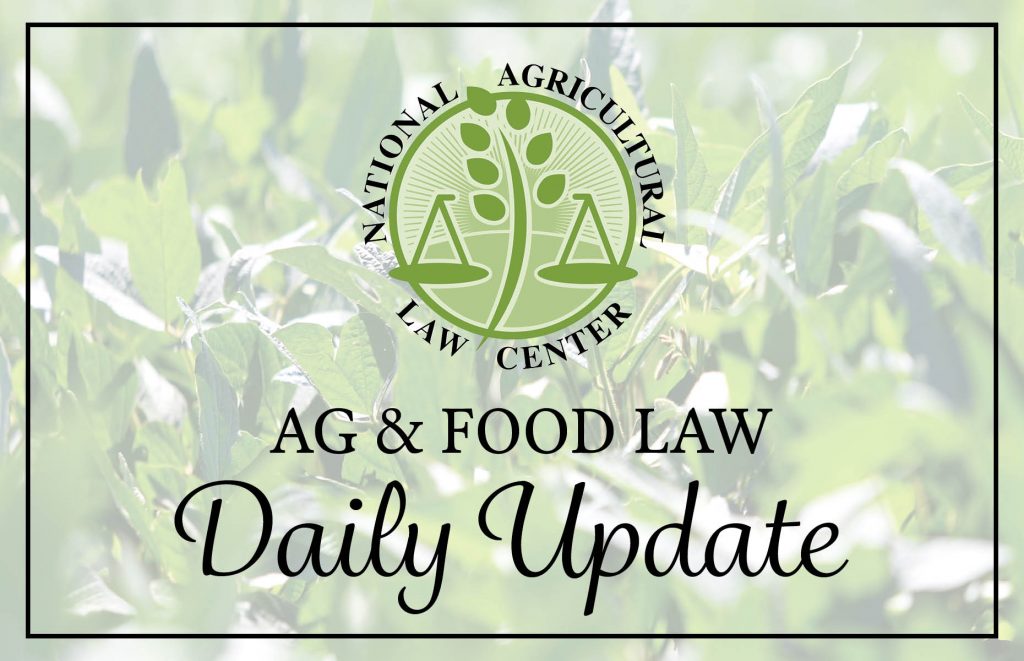A comprehensive summary of today’s judicial, legislative, and regulatory developments in agriculture and food. Email important additions HERE.
JUDICIAL: Includes food law, food labeling
In Hawyuan Yu v. Dr Pepper Snapple Group, Inc., No. 18-CV-06664-BLF, 2020 WL 5910071 (N.D. Cal. Oct. 6, 2020), the plaintiff brought his complaint against the defendants on behalf of a putative class, arguing that the defendants had mislead consumers by selling apple juice and applesauce products with the representation “Natural” and/or “All Natural Ingredients” despite the fact that the products contain trace amounts of pesticide. This is the second time the plaintiff has brought this complaint. This complaint contains the same five actions as the first, but adds two surveys to the allegations. The defendants asked the court to dismiss the plaintiff’s complaint because the Ninth Circuit had already concluded that the surveys were not enough to sustain the plaintiff’s claims.
The plaintiff in this case proposes a nationwide class of consumers who purchased the defendants’ products under the assumption that the labeling “Natural” and/or “All Natural Ingredients” meant that the products did not contain synthetic or unnatural pesticides, even in residual amounts. When the plaintiff filed the first complaint in this case, the defendants asked the court to dismiss the complaint because the plaintiff had failed to plausibly allege that a “reasonable consumer” would interpret the terms “Natural” and “All Natural Ingredients” to mean “the utter absence of residual pesticides.” The court granted the defendant’s request and dismissed the complaint. However, the court allowed the plaintiff the opportunity to amend his complaint so that it contained enough evidence to support his claims and proceed with the case. For his complaint to meet the “reasonable consumer” test, the plaintiff must show that it is probable “that a significant portion of the general consuming public or of targeted consumers, acting reasonably in the circumstances, could be misled.” To meet that test, the plaintiff cited two consumer surveys which both indicated that about two thirds of consumers would not consider food sprayed with synthetic pesticides to be “natural.” However, the Ninth Circuit, the jurisdiction where this case is located, has previously held that a plaintiff cannot rely on consumer surveys alone to create a plausible allegation that reasonable consumers are misled.
Based on that holding from the Ninth Circuit, the defendants asked the court to dismiss the plaintiff’s second complaint. The court granted the defendant’s request, dismissing the complaint with prejudice because the plaintiff had twice failed to allege plausible claims. By dismissing with prejudice, the court has denied the plaintiff any future chance of refiling his claims against the defendant.
REGULATORY: Includes EPA, FWS, and NOAA
ENVIRONMENTAL PROTECTION AGENCY
Final rule establishing tolerances for residues of the insecticide afidopyropen, including its metabolites and degradates, in or on multiple food and animal commodities identified and discussed. Info here.
Notification of a draft regulatory document concerning “Pesticides; Agricultural Worker Protection Standard; Revision of the Application Exclusion Zone Requirements (RIN 2070-AK49)” being submitted to the Secretary of Agriculture. Info here.
Final rule establishes time-limited tolerances for residues of kasugamycin in or on almonds. Info here.
FISH AND WILDLIFE SERVICE
Final rule determines threatened species status for the eastern black rail (Laterallus jamaicensis jamaicensis) under the Endangered Species Act of 1973 (Act), as amended. Accordingly, we list the eastern black rail, a bird subspecies known from as many as 35 States, the District of Columbia, Puerto Rico, Canada, Brazil, and several countries in the Caribbean and Central America, as a threatened species under the Act. Info here.
Final rule determines threatened species status under the Endangered Species Act of 1973 (Act), as amended, for the coastal distinct population segment (DPS) of Pacific marten (Martes caurina), a small mammal from coastal California and Oregon. Info here.
Proposed rule to reclassify the red-cockaded woodpecker (Dryobates (= Picoides) borealis) as a threatened species with a rule issued under section 4(d) of the Endangered Species Act of 1973 (Act), as amended. Info here.
NATIONAL OCEANIC AND ATMOSPHERIC ADMINISTRATION
Notification NMFS announces that the State of New Hampshire is transferring a portion of its 2020 commercial bluefish quota to the State of North Carolina. Info here.
Notification NMFS is publishing its final 2020 List of Foreign Fisheries (LOFF), as required by the regulation implementing the Fish and Fish Product Import Provisions of the Marine Mammal Protection Act (MMPA). Info here.
